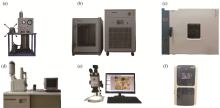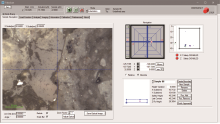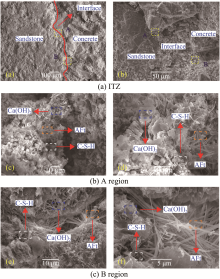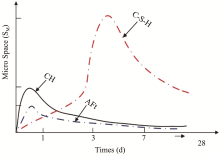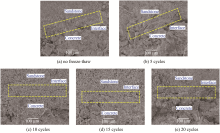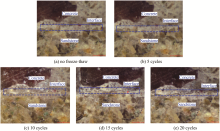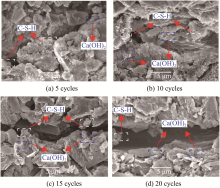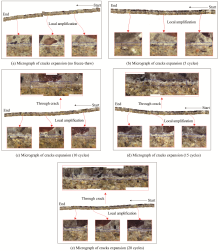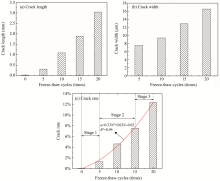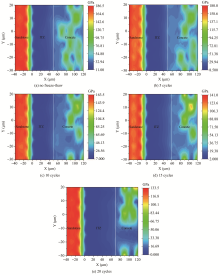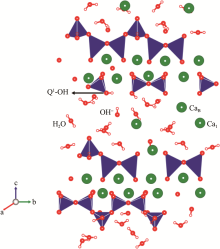Sciences in Cold and Arid Regions ›› 2021, Vol. 13 ›› Issue (2): 133–149.doi: 10.3724/SP.J.1226.2021.20056
• • 上一篇
Sandstone-concrete interface transition zone (ITZ) damage and debonding micromechanisms under freeze-thaw
YanJun Shen1,2,3,Huan Zhang4( ),JinYuan Zhang4(
),JinYuan Zhang4( ),HongWei Yang4,Xu Wang4,Jia Pan4
),HongWei Yang4,Xu Wang4,Jia Pan4
- 1.School of Geology and Environment, Xi'an University of Science and Technology, Xi'an, Shaanxi 710054, China
2.Geological Research Institute for Coal Green Mining, Xi'an University of Science and Technology, Xi'an, Shaanxi 710054, China
3.Shaanxi Provincial Key Laboratory of Geological Support for Coal Green Exploitation, Xi'an, Shaanxi 710054, China
4.School of Architecture and Civil Engineering, Xi'an University of Science and Technology, Xi'an, Shaanxi 710054, China
|
Andjelkovic V, Pavlovic N, Lazarevic Z, et al., 2015. Modelling of shear characteristics at the concrete-rock mass interface. International Journal of Rock Mechanics and Mining Sciences, 76: 222-236. DOI: 10.1016/j.ijrmms.2015.03.024.
doi: 10.1016/j.ijrmms.2015.03.024 |
|
|
Badeli S, Carter A, Doré G, 2018. Complex modulus and fatigue analysis of asphalt mix after daily rapid freeze-thaw cycles. Journal of Materials in Civil Engineering, 30(4): 04018056. DOI: 10.1061/(ASCE)MT.1943-5533.0002236.
doi: 10.1061/(ASCE)MT.1943-5533.0002236 |
|
|
Bandini A, Berry P, Bemporad E, et al., 2012. Effects of intra-crystalline microcracks on the mechanical behavior of a marble under indentation. International Journal of Rock Mechanics and Mining Sciences, 54: 47-55. DOI: 10.1016/j.ijrmms.2012.05.024.
doi: 10.1016/j.ijrmms.2012.05.024 |
|
|
Barnes BD, Diamond S, Dolch WL, 1978. The contact zone between portland cement paste and glass "aggregate" surfaces. Cement and Concrete Research, 8(2): 233-243. DOI: 10.1016/0008-8846(78)90012-1.
doi: 10.1016/0008-8846(78)90012-1 |
|
|
Barnes BD, Diamond S, Dolch WL, 1979. Micromorphology of the Interfacial Zone Around Aggregates in Portland Cement Mortar. Journal of the American Ceramic Society, 62(1-2): 21-24. DOI: 10.1111/j.1151-2916.1979.tb18797.x.
doi: 10.1111/j.1151-2916.1979.tb18797.x |
|
|
Cui S, Xu D, Liu P, et al., 2017. Exploratory study on improving bond strength of shotcrete in hot and dry environments of high geothermal tunnels. KSCE Journal of Civil Engineering, 21(6): 2245-2251. DOI: 10.1007/s12205-016-0901-y.
doi: 10.1007/s12205-016-0901-y |
|
|
Cui S, Zhu B, Li F, et al., 2016. Experimental study on bond performance between shotcrete and rock in a hot and humid tunnel environment. KSCE Journal of Civil Engineering, 20(4): 1385-1391. DOI: 10.1007/s12205-015-0159-9.
doi: 10.1007/s12205-015-0159-9 |
|
|
Cwirzen A, Penttala V, 2005. Aggregate-cement paste transition zone properties affecting the salt-frost damage of high-performance concretes. Cement and Concrete Research, 35(4): 671-679. DOI: 10.1016/j.cemconres.2004.06.009.
doi: 10.1016/j.cemconres.2004.06.009 |
|
|
Dharmawardhana C, Bakare M, Misra A, et al., 2016. Nature of interatomic bonding in controlling the mechanical properties of calcium silicate hydrates. Journal of the American Ceramic Society, 99(6): 2120-2130. DOI: 10.1111/jace. 14214.
doi: 10.1111/jace. 14214 |
|
|
Dharmawardhana C, Misra A, Ching W, 2014. Quantum mechanical metric for internal cohesion in cement crystals. Scientific Reports, 4: 7332-7332. DOI: 10.1038/srep07332.
doi: 10.1038/srep07332 |
|
|
Diamond S, 2001. Considerations in image analysis as applied to investigations of the ITZ in concrete. Cement and Concrete Composites, 23(2): 171-178. DOI: 10.1016/S0958-9465(00)00085-8.
doi: 10.1016/S0958-9465(00)00085-8 |
|
|
Dong W, Wu Z, Zhou X, et al., 2017. An experimental study on crack propagation at rock-concrete interface using digital image correlation technique. Engineering Fracture Mechanics, 171: 50-63. DOI: 10.1016/j.engfracmech.2016. 12.003.
doi: 10.1016/j.engfracmech.2016. 12.003 |
|
| Du H, Radonjic M, 2018. Comparison of Micro/Nano-Indentation Results for Pottsville and Marcellus Shale. 52nd U.S. Rock Mechanics/Geomechanics Symposium: 6. | |
| Fan L, Zhao Q, Zhang J, et al., 2019. Experimental study on the structure properties and interface interference of the interface transition zone (ITZ) of cement-based materials. Journal of HeBei University of Water Resources and Electric Engineering, 3: 26-33. | |
| Gao J, Pan J, 2000. Preliminary study on the cause of the weak link of the new and old concrete interface. Concrete, 6: 44-46. | |
|
Gao Y, Zhu X, Corr DJ, et al., 2019. Characterization of the interfacial transition zone of CNF-Reinforced cementitious composites. Cement and Concrete Composites, 99: 130-139. DOI: 10.1016/j.cemconcomp.2019.03.002.
doi: 10.1016/j.cemconcomp.2019.03.002 |
|
| Guo K, Ma H, Yang F, et al., 2020. Micromechanical properties of GO-RC interface transition zone under freeze-thaw cycles. Journal of Building Materials, 23(1): 230-238. | |
|
He S, Li Z, Yang EH, 2019. Quantitative characterization of anisotropic properties of the interfacial transition zone (ITZ) between microfiber and cement paste. Cement and Concrete Research, 122: 136-146. DOI: 10.1016/j.cemconres.2019.05.007.
doi: 10.1016/j.cemconres.2019.05.007 |
|
|
Ho CH, Chivens K, Floyd S, et al., 2019. Preliminary evaluation of concrete-rock interface behavior under the action of freeze-thaw cycles. In: Ibraim E, Tarantino A (eds.). 7th International Symposium on Deformation Characteristics of Geomaterials, IS-Glasgow2019.
doi: 10.1051/e3sconf/20199213012 |
|
|
Sciences EDP, 13012. DOI: 10.1051/e3sconf/20199213012.
doi: 10.1051/e3sconf/20199213012 |
|
|
Hussin A, Poole C, 2011. Petrography evidence of the interfacial transition zone (ITZ) in the normal strength concrete containing granitic and limestone aggregates. Construction and Building Materials, 25(5): 2298-2303. DOI: 10.1016/j.conbuildmat.2010.11.023.
doi: 10.1016/j.conbuildmat.2010.11.023 |
|
|
Igarashi S, Bentur A, Mindess S, 1996. Microhardness testing of cementitious materials. Advanced Cement Based Materials, 4(2): 48-57. DOI: 10.1016/S1065-7355(96)90051-6.
doi: 10.1016/S1065-7355(96)90051-6 |
|
|
Jennings HM, 2000. A model for the microstructure of calcium silicate hydrate in cement paste. Cement and Concrete Research, 30(1): 101-116. DOI: 10.1016/S0008-8846(99)00209-4.
doi: 10.1016/S0008-8846(99)00209-4 |
|
|
Kim JY, Lee JJ, Lee YH, et al., 2006. Surface roughness effect in instrumented indentation: A simple contact depth model and its verification. Journal of Materials Research, 21(12): 2975-2978. DOI: 10.1557/jmr.2006.0370.
doi: 10.1557/jmr.2006.0370 |
|
|
Krounis A, Johansson F, Larsson S, 2015. Effects of spatial variation in cohesion over the concrete-rock interface on dam sliding stability. Journal of Rock Mechanics and Geotechnical Engineering, 7(6): 659-667. DOI: 10.1016/j.jrmge.2015.08.005.
doi: 10.1016/j.jrmge.2015.08.005 |
|
|
Krounis A, Johansson F, Larsson S, 2016. Shear strength of partially bonded concrete-rock interfaces for application in dam stability analyses. Rock Mechanics and Rock Engineering, 49(7): 2711-2722. DOI: 10.1007/s00603-016-0962-8.
doi: 10.1007/s00603-016-0962-8 |
|
|
Kuroda M, Watanabe T, Terashi N, 2000. Increase of bond strength at interfacial transition zone by the use of fly ash. Cement and Concrete Research, 30(2): 253-258. DOI: 10.1016/S0008-8846(99)00241-0.
doi: 10.1016/S0008-8846(99)00241-0 |
|
|
Lam Thomas SK, Johnston Ian W, 1989. Shear behavior of regular triangular concrete/rock joints—evaluation. Journal of Geotechnical Engineering, 115(5): 728-740. DOI: 10.1061/(ASCE)0733-9410(1989)115:5(728).
doi: 10.1061/(ASCE)0733-9410(1989)115:5(728 |
|
|
Lo K, Ogawa T, Lukajic B, et al., 1991. Measurements of strength parameters of concrete-rock contact at the dam-foundation interface. Geotechnical Testing Journal, 14(4): 383-394. DOI: 10.1520/GTJ10206J.
doi: 10.1520/GTJ10206J |
|
|
Lothenbach B, Nonat A, 2015. Calcium silicate hydrates: Solid and liquid phase composition. Cement and Concrete Research, 78: 57-70. DOI: 10.1016/j.cemconres.2015.03.019.
doi: 10.1016/j.cemconres.2015.03.019 |
|
|
Li B, Chen W, 2019. Development on molecular structure of calcium silicate hydrate gel. Journal of The Chinese Ceramic Society, 47(8): 1095-1100. DOI: 10.14062/j.issn.0454-5648.2019.08.10.
doi: 10.14062/j.issn.0454-5648.2019.08.10 |
|
| Li J, Cao J, Xu W, et al., 1999. Research on freeze-thaw failure mechanism of concrete. Journal of Hydraulic Engineering, 30(1): 42-50. | |
|
Liu K, Ostadhassan M, Bubach B, 2016. Applications of nano-indentation methods to estimate nanoscale mechanical properties of shale reservoir rocks. Journal of Natural Gas Science and Engineering, 35: 1310-1319. DOI: 10.1016/j.jngse.2016.09.068.
doi: 10.1016/j.jngse.2016.09.068 |
|
|
Liu QS, Huang SB, Kang YS, et al., 2015. Numerical and theoretical studies on frost heaving pressure in a single fracture of frozen rock mass under low temperature. Chinese Journal of Geotechnical Engineering, 37(9): 1572-1580. DOI: 10.11779/CJGE201509003.
doi: 10.11779/CJGE201509003 |
|
|
Luo T, Zhang C, Xu X, et al., 2020. Effects of cyclic freeze-thaw on the steel bar reinforced new-to-old concrete interface. Molecules, 25: 1251. DOI: 10.3390/molecules25051251.
doi: 10.3390/molecules25051251 |
|
|
Magnenet V, Auvray C, Francius G, et al., 2011. Determination of the matrix indentation modulus of Meuse/Haute-Marne argillite. Applied Clay Science, 52(3): 266-269. DOI: 10. 1016/j.clay.2011.03.001.
doi: 10. 1016/j.clay.2011.03.001 |
|
|
Mainali G, Dineva S, Nordlund E, 2015. Experimental study on debonding of shotcrete with acoustic emission during freezing and thawing cycle. Cold Regions Science and Technology, 111: 1-12. DOI: 10.1016/j.coldregions.2014. 11.014.
doi: 10.1016/j.coldregions.2014. 11.014 |
|
| Mellor M, 1970. Phase Composition of Pore Water in Cold Rocks. U.S. Army Cold Regions Research and Engineering Lab., Rep., 292: 66. | |
|
Mondal P, Shah S, Marks L, 2009. Nanomechanical Properties of Interfacial Transition Zone in Concrete. In: Bittnar Z, Bartos PJM, Němeček J, Šmilauer V, Zeman J (eds.). Nanotechnology in Construction3.
doi: 10.1007/978-3-642-00980-8_42 |
|
|
Springer, Berlin. DOI: 10.1007/978-3-642-00980-8_42.
doi: 10.1007/978-3-642-00980-8_42 |
|
|
Mouzannar H, Bost M, Leroux M, et al., 2017. Experimental study of the Shear Strength of Bonded Concrete-Rock Interfaces: Surface Morphology and Scale Effect. Rock Mechanics and Rock Engineering, 50(10): 2601-2625. DOI: 10.1007/s00603-017-1259-2.
doi: 10.1007/s00603-017-1259-2 |
|
|
Němeček J, 2009. Creep effects in nanoindentation of hydrated phases of cement pastes. Materials Characterization, 60(9): 1028-1034. DOI: 10.1016/j.matchar.2009.04.008.
doi: 10.1016/j.matchar.2009.04.008 |
|
|
Nix WD, Gao H, 1998. Indentation size effects in crystalline materials: A law for strain gradient plasticity. Journal of the Mechanics and Physics of Solids, 46(3): 411-425. DOI: 10.1016/S0022-5096(97)00086-0.
doi: 10.1016/S0022-5096(97)00086-0 |
|
|
Pellenq RJM, Lequeux N, van Damme H, 2008. Engineering the bonding scheme in C-S-H: The iono-covalent framework. Cement and Concrete Research, 38(2): 159-174. DOI: 10.1016/j.cemconres.2007.09.026.
doi: 10.1016/j.cemconres.2007.09.026 |
|
|
Phillips M, Wolter A, Lüthi R, et al., 2017. Rock slope failure in a recently deglaciated permafrost rock wall at Piz Kesch (EasternSwiss Alps), February 2014. Earth Surface Processes and Landforms, 42(3): 426-438. DOI: 10.1002/esp.3992.
doi: 10.1002/esp.3992 |
|
|
Renaud S, Saichi T, Bouaanani N, et al., 2019. Roughness effects on the shear strength of concrete and rock joints in dams based on experimental data. Rock Mechanics and Rock Engineering, 52(10): 3867-3888. DOI: 10.1007/s00603-019-01803-x.
doi: 10.1007/s00603-019-01803-x |
|
|
Sáez del Bosque IF, Zhu W, Howind T, et al., 2017. Properties of interfacial transition zones (ITZs) in concrete containing recycled mixed aggregate. Cement and Concrete Composites, 81: 25-34. DOI: 10.1016/j.cemconcomp.2017.04.011.
doi: 10.1016/j.cemconcomp.2017.04.011 |
|
|
Shen Y, Wang Y, Wei X, et al., 2020a. Investigation on meso-debonding process of the sandstone-concrete interface induced by freeze-thaw cycles using NMR technology. Construction and Building Materials, 252: 118962. DOI: 10. 1016/j.conbuildmat.2020.118962.
doi: 10. 1016/j.conbuildmat.2020.118962 |
|
|
Shen Y, Wang Y, Yang Y, et al., 2019. Influence of surface roughness and hydrophilicity on bonding strength of concrete-rock interface. Construction and Building Materials, 213: 156-166. DOI: 10.1016/j.conbuildmat.2019.04.078.
doi: 10.1016/j.conbuildmat.2019.04.078 |
|
|
Shen Y, Yang H, Xi J, et al., 2020b. A novel shearing fracture morphology method to assess the influence of freeze-thaw actions on concrete-granite interface. Cold Regions Science and Technology, 169: 102900. DOI: 10.3389/feart. 2019.00333.
doi: 10.3389/feart. 2019.00333 |
|
|
Shen Y, Yang G, Rong T, et al., 2016. Proposed scheme for freeze-thaw tests on rock. Chinese Journal of Rock Mechanics and Engineering, 38(10): 1775-1782. DOI: 10. 11779/CJGE.2016.10.005.
doi: 10. 11779/CJGE.2016.10.005 |
|
| Shui Z, Wan H, 2002a. Aggregate-cement interface transition zone in old concrete (ITZ) (Ⅰ)—Enrichment of elements and compounds in ITZ. Journal of Wuhan University of Technology, 24(4): 21-23. | |
| Shui Z, Wan H, 2002b. Aggregate-cement interface transition zone (ITZ) in old concrete (Ⅱ)—The distribution characteristics of elements in the interface zone. Journal of Wuhan University of Technology, 24(5): 22-25. | |
|
Sorelli L, Constantinides G, Ulm FJ, et al., 2008. The nano-mechanical signature of Ultra High Performance Concrete by statistical nanoindentation techniques. Cement and Concrete Research, 38(12): 1447-1456. DOI: j.cemconres. 2008.09.002.
doi: j.cemconres. 2008.09.002 |
|
|
Su X, Chen P, Ma T, 2019. Evaluation of shale fracture toughness based on micrometer indentation test. Petroleum, 5(1): 52-57. DOI: 10.1016/j.petlm.2018.05.005.
doi: 10.1016/j.petlm.2018.05.005 |
|
|
Tang Y, Xu G, Lian J, et al., 2016. Effect of temperature and humidity on the adhesion strength and damage mechanism of shotcrete-surrounded rock. Construction and Building Materials, 124: 1109-1119. DOI: j.conbuildmat.2016.08.126.
doi: j.conbuildmat.2016.08.126 |
|
|
Taylor HFW, 1993. Nanostructure of C-S-H: Current status. Advanced Cement Based Materials, 1(1): 38-46. DOI: 10. 1016/1065-7355(93)90006-A.
doi: 10. 1016/1065-7355(93)90006-A |
|
|
Tong J, Karakus M, Wang M, et al., 2016. Shear strength characteristics of shotcrete-rock interface for a tunnel driven in high rock temperature environment. Geomechanics and Geophysics for Geo-Energy and Geo-Resources, 2(4): 331-341. DOI: 10.1007/s40948-016-0039-x.
doi: 10.1007/s40948-016-0039-x |
|
|
Tian HM, Chen W, Yang D, et al., 2014. Experimental and numerical analysis of the shear behaviour of cemented concrete-rock joints. Rock Mechanics and Rock Engineering, 48: 213-222. DOI: 10.1007/s00603-014-0560-6.
doi: 10.1007/s00603-014-0560-6 |
|
|
Velez K, Maximilien S, Damidot D, et al., 2001. Determination by nanoindentation of elastic modulus and hardness of pure constituents of Portland cement clinker. Cement and Concrete Research, 31(4): 555-561. DOI: 10.1016/S0008-8846(00)00505-6.
doi: 10.1016/S0008-8846(00)00505-6 |
|
|
Wang M, Xie Y, Long G, et al., 2019. Microhardness characteristics of high-strength cement paste and interfacial transition zone at different curing regimes. Construction and Building Materials, 221: 151-162. DOI: 10.1016/j.conbuildmat.2019.06.084.
doi: 10.1016/j.conbuildmat.2019.06.084 |
|
|
Wang T, Zhou G, Wang J, et al., 2018a. Stochastic analysis of uncertainty mechanical characteristics for surrounding rock and lining in cold region tunnels. Cold Regions Science and Technology, 145: 160-168. DOI: 10.1016/j.coldregions.2017.10.016.
doi: 10.1016/j.coldregions.2017.10.016 |
|
|
Wang W, Qin Y, Lei M, et al., 2018b. Effect of repeated freeze-thaw cycles on the resilient modulus for fine-grained subgrade soils with low plasticity index. Road Materials and Pavement Design, 19(4): 898-911. DOI: 10. 1080/14680629.2017.1283352.
doi: 10. 1080/14680629.2017.1283352 |
|
|
Wang XH, Jacobsen S, He JY, et al., 2009. Application of nanoindentation testing to study of the interfacial transition zone in steel fiber reinforced mortar. Cement and Concrete Research, 39(8): 701-715. DOI: 10.1016/j.cemconres. 2009.05.002.
doi: 10.1016/j.cemconres. 2009.05.002 |
|
| Xiang W, Liu X, 2010. Experimental study of mechanical properties of combined specimen with rock and shotcrete under freezing-thawing cycles. Chinese Journal of Rock Mechanics and Engineering, 29(12): 2510-2521. | |
|
Xiao J, Li W, Sun Z, et al., 2013. Properties of interfacial transition zones in recycled aggregate concrete tested by nanoindentation. Cement and Concrete Composites, 37: 276-292. DOI: 10.1016/j.cemconcomp.2013.01.006.
doi: 10.1016/j.cemconcomp.2013.01.006 |
|
|
Xie H, Li G, Xiong G, 2002. Microstructure model of the interfacial zone between fresh and old concrete. Journal of Wuhan University of Technology-Mater. Sci. Ed., 17(4): 64-68. DOI: 10.1007/BF02838421.
doi: 10.1007/BF02838421 |
|
|
Xu L, Deng F, Chi Y, 2017. Nano-mechanical behavior of the interfacial transition zone between steel-polypropylene fiber and cement paste. Construction and Building Materials, 145: 619-638. DOI: 10.1016/j.conbuildmat.2017.04.035.
doi: 10.1016/j.conbuildmat.2017.04.035 |
|
|
Xu L, Yu H, Chi Y, et al., 2016. Nano-indentation character of interfacial transition zone between steel fiber and cement paste. Journal of the Chinese Ceramic Society, 44: 1134-1146. DOI: 10.14062/j.issn.0454-5648.2016.08.09.
doi: 10.14062/j.issn.0454-5648.2016.08.09 |
|
|
Yang X, Shen A, Guo Y, et al., 2018. Deterioration mechanism of interface transition zone of concrete pavement under fatigue load and freeze-thaw coupling in cold climatic areas. Construction and Building Materials, 160: 588-597. DOI: 10.1016/j.conbuildmat.2017.11.031.
doi: 10.1016/j.conbuildmat.2017.11.031 |
|
|
Zampini D, Shah SP, Jennings HM, 1998. Early age microstructure of the paste-aggregate interface and its evolution. Journal of Materials Research, 13(7): 1888-1898. DOI: 10. 1557/JMR.1998.0268.
doi: 10. 1557/JMR.1998.0268 |
|
|
Zanjani Zadeh V, Bobko CP, 2014. Nano-mechanical properties of internally cured kenaf fiber reinforced concrete using nanoindentation. Cement and Concrete Composites, 52: 9-17. DOI: 10.1016/j.cemconcomp.2014.04.002.
doi: 10.1016/j.cemconcomp.2014.04.002 |
| No related articles found! |
|
||



